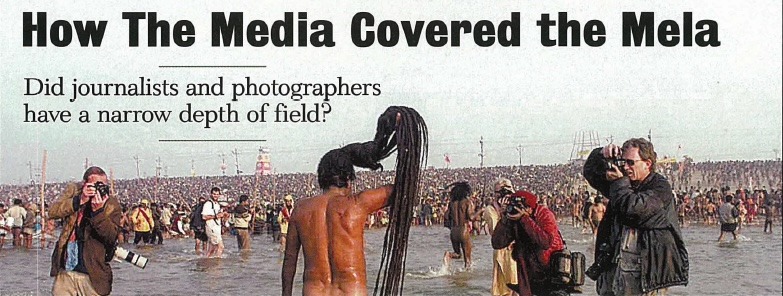Sooner or later, some conscience-struck journalism student will finally send Hinduism Today a copy of “The Journalist’s Guide to Reporting on Hinduism.” We already know what is in it: “If you are a journalist posted to Delhi for a year, then proceed in sequence to report on the following items: child marriages, widow burning and abandonment, bride burning and beating, caste oppression, the Ram temple, Hindu fundamentalists, harassment of Christians, phony gurus, greedy priests and, when you really have nothing else to report, the rat temple. At no time in your reports shall you extol Hinduism or ever compare any of these topics to identical or parallel issues in the West, such as teenage pregnancies, abuse of the aged, domestic violence, racial and ethnic discrimination, Christian fundamentalists, harassment of religious minorities, disgraced preachers, pedophile priests, or even the pervasive mistreatment of laboratory rats.”
We believe another section of this Guide to say, “And if by great good fortune, you are in India or sent there for the Kumbha Mela, the single greatest gathering of humanity for any purpose whatsoever, let alone a sacred one, make little or nothing of that fact. Instead, your sole duty shall be to talk to naked sadhus, take pictures of naked sadhus and report and comment derisively on naked sadhus. Be sure to photograph them smoking ganja [marijuana, sometimes hashish]. Open every story with something about naked sadhus. Relegate all reports on other saints and all pilgrims–except famous Western movie stars–to the end of your report, where they may most easily be cut out.”
Unwarranted exaggeration, you say? Consider what happened right from the get-go on January 11. That’s when the UK’s Channel 4 launched its coverage with extended shots of naked sadhus. Britain’s National Council of Hindu Temples, representing more than 600,000 Hindus and 140 temples, complained loudly. Their spokesman said, “When I saw the documentary, it seemed as though Hinduism was all about smoking ganja. For 70 percent of the time, they’re talking to sadhus who are smoking ganja and doing nothing else. The person who sees the footage will ask, “Is this what Hinduism is about?’ I’m not saying that what they portrayed does not happen, but this is not normal, mainstream Hinduism. No one explained what the Mela is really about.”
François Gautier, reporter for France’s largest circulation newspaper, Le Figaro, is one of the few Western reporters not following the rules, and in a recent editorial he discussed this very issue. “There was a very symbolic photo published by the Indian Express during the early days of the Kumbha Mela, a naga sannyasin wanting to take a quiet dip in the Sangam, was trying to shoo away a group of (mostly) Western photographers. The fully-dressed lensmen versus the naked sadhu, might have given the impression of civilization versus Paganism, enlightenment versus Middle Age, as if the educated world was photographing the monkey. It was at times as if the Western press was reflecting the images of a colonial India: mysterious Pagan rites, naked sadhus, teeming masses praying to an alien God. Very few foreign newspapers cared to say that it is extraordinary that in the 21st century tens of millions of people endure endless travels, hunger, cold and discomfort to pray to That which is beyond us. These millions of people, mostly poor folks from the rural areas, are embodying the best of India: its virtues of tolerance, gentleness, patience, faith and simplicity.”
Gautier did not spare the local media, “During this Mela: very few Indian newspapers and magazines showed that they were proud of their own culture, or highlighted the fact that for once, the Indian Government did a wonderful job. There has never been such a huge congregation of people. Yet everything is working. Water is flowing, electricity is on all the time. Roads are watered periodically to restrain dust, and the place is extremely clean for Indian standards, thanks in part to a us$32 million contribution by the Central Government.”
India Today and India Abroad, both widely distributed in America, managed just about the same lurid coverage, two Naga sadhu photos each, two of ganja for India Today and one for India Abroad. India Today even captioned one of the ganja photos, “literal evidence of religion as opiate”–a slur harking back to Karl Marx’s dismissal of religion as “the opiate of the people.”
Finally, Western reporters seem woefully ignorant of factual details of Hinduism. Some didn’t know the white substance on a sadhu was holy ash and called it “paint.” Many called the Nagas Hinduism’s “highest priests,” which they are not, though they are greatly revered for their asceticism. One even called the Ganga water “warm” when it is freezing cold. Some reporters did do a good overall job. But even someone knowledgeable about Hinduism, such as Mike Wolbridge of the BBC, still devoted much of one of his last reports to an interview with a stoned British pilgrim. Nearly every newspaper launched into their report with Naga sadhus storming the river for their bath. It may sell newspapers, but it does little justice to the extraordinary holy event which took place.


